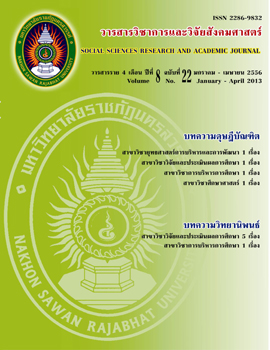รูปแบบความสัมพันธ์โครงสร้างเชิงสาเหตุของภาวะผู้นำของผู้บริหารหน่วยงานสังกัดสำนักงานอธิการบดี มหาวิทยาลัยของรัฐ
Main Article Content
Abstract
บทคัดย่อ
การวิจัยครั้งนี้ มีวัตถุประสงค์เพื่อพัฒนารูปแบบความสัมพันธ์โครงสร้างเชิงสาเหตุของภาวะผู้นำของผู้บริหารหน่วยงาน สังกัดสำนักงานอธิการบดี มหาวิทยาลัยของรัฐ กลุ่มตัวอย่างที่ใช้ในการวิจัยครั้งนี้ ได้แก่ ผู้บริหารหน่วยงาน สังกัดสำนักงานอธิการบดี มหาวิทยาลัยของรัฐ จำนวน 340 คน ได้มาโดยการสุ่มแบบแบ่งชั้น เครื่องมือที่ใช้ในการวิจัยเป็นแบบสอบถามจำนวน 92 ข้อ มีค่าอำนาจจำแนกรายข้ออยู่ระหว่าง .43-.82 มีค่าความเชื่อมั่นอยู่ระหว่าง .66-.95 วิเคราะห์ข้อมูลโดยการวิเคราะห์ความสัมพันธ์เชิงสาเหตุ
ผลการวิจัยพบว่า
รูปแบบความสัมพันธ์โครงสร้างเชิงสาเหตุของภาวะผู้นำ ของผู้บริหารหน่วยงานสังกัดสำนักงานอธิการบดีมหาวิทยาลัยของรัฐประกอบด้วย 5 ปัจจัยได้แก่ พฤติกรรมการบริหารของผู้บริหารระดับสูงสถานการณ์ที่เอื้อต่อการบริหารงาน คุณลักษณะของผู้บริหารหน่วยงาน ภาวะผู้ตาม และภาวะผู้นำ โดยรูปแบบที่ประหยัดที่สุดดังกล่าว พบว่า มีความสอดคล้องกับข้อมูลเชิงประจักษ์ตามค่าดัชนีที่กำหนดไว้เป็นเกณฑ์สำหรับประเมินความเหมาะสมของรูปแบบทุกค่า (x2 =93.83 df=74 P-value= .06 RMSEA= .03 GFI= .97 AGFI= .94 CFI=1.00 NFI= .99 NNFI=1.00 CN=365.87) และเมื่อพิจารณาความสัมพันธ์เชิงสาเหตุของปัจจัยในรูปแบบจากค่าอิทธิพลต่างๆพบว่า พฤติกรรมการบริหารของผู้บริหารระดับสูง ส่งผลทางอ้อมต่อภาวะผู้นำโดยผ่านสถานการณ์ที่เอื้อต่อการบริหารงาน คุณลักษณะของผู้บริหารหน่วยงาน และภาวะผู้ตาม ในทำนองเดียวกันกับสถานการณ์ที่เอื้อต่อการบริหารงานส่งผลทางอ้อมต่อภาวะผู้นำโดยผ่านคุณลักษณะของผู้บริหารหน่วยงาน และภาวะผู้ตาม สำหรับคุณลักษณะของผู้บริหารหน่วยงานพบว่า ส่งผลทางตรงและทางอ้อมต่อภาวะผู้นำผ่านภาวะผู้ตาม โดยภาวะผู้ตามส่งผลทางตรงต่อภาวะผู้นำ
Abstracts
The research aimed to develop the causal structural relationship model of leadership of the administrators in the president’s offices of the government universities and to examine the congruence of the causal structural relationship model of leadership of the administrators in the president’s offices of the government universities with the empirical collected data. A total of 340 administrators selected by stratified sampling technique were employed as the sample of the study. A five-scale rating survey questionnaire containing 92 items and yielding discriminating power between .43 to .82 and reliability coefficient between .66 to .95 was utilized in data collection. The statistics used in data analysis were confirmed factor analysis and LISREL program for casual relationship analysis (LISREL 8.80).
The research findings were as follows:
The causal structural relationship model of leadership of the administrators in the president’s offices of the government universities consisted of 5 factors, namely behavior of executive administrators, circumstances favorable to administration, characteristics of administrators, followership, and leadership. The constructed model was found to accord with the empirical data as shown in statistical values/indicators established to be an indicator for model evaluation (x2 =93.83 df=74 P-value= .06 RMSEA= .03 GFI= .97 AGFI= .94 CFI=1.00 NFI= .99 NNFI =1.00 CN =365.87). When looking closer at the relationship among the factors, it was found that the behavior of executive administrators indirectly affected leadership through the circumstances favorable to administration, characteristics of administrators, and followership respectively. Similarly, circumstances favorable to administration indirectly affected leadership through characteristics of administrators and followership. The characteristics of administrators were found to be indirectly and directly influential on leadership through followership. The followership was found to directly affect leadership.


